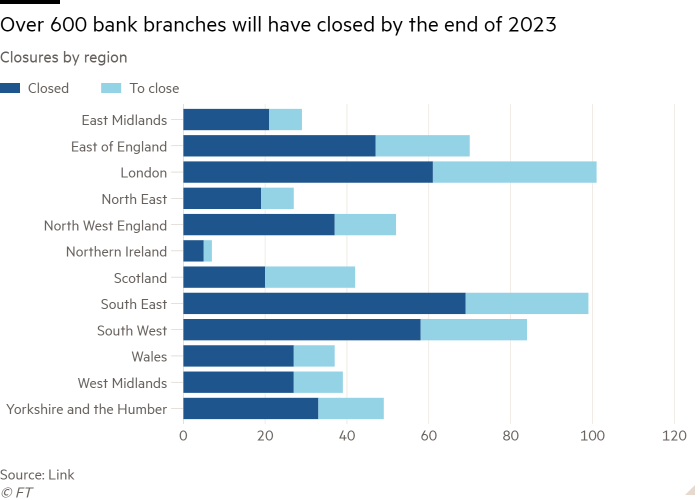More than one in eight UK bank branches to close in 2023

Simply sign up to the UK banks myFT Digest -- delivered directly to your inbox.
More than one in eight UK bank branches that were open at the start of 2023 will have closed by December, with almost three-fifths of the network vanishing since 2015.
Financial Times analysis, based on data from ATM provider Link, shows that a total of 636 bank branches are due to close by the end of this year, with 424 shut so far. Another 42 have already been announced for 2024.
The closures underline the growing sparsity of cash infrastructure across the country, despite government proposals last month to ensure long-term access to cash.
“A closed bank branch doesn’t just mean one less place to withdraw or deposit cash locally,” said Sam Richardson, deputy editor of consumer rights magazine Which? Money. “[It] also makes getting access to face-to-face banking services harder — something that is particularly important for more vulnerable customers.”
Consumer group Which? estimates that after this year’s closures, there will be just over 4,000 branches left across the UK, with 5,600 having closed since January 2015, when it began tracking the data.
Banks have been cutting back expensive branch networks for decades, but the rate has grown with the increased uptake of digital alternatives in recent years, and was supercharged by the pandemic.
Derek French, a former NatWest executive, said the nature of branch closures had changed since 2016, when the campaign for community banking services, which he founded, closed down.
“It used to be very much a rural problem in small towns and large villages,” he said, “but increasingly, it’s happening in larger towns, which support the surrounding hinterland, which lost their branches donkey’s years ago.”
In addition to the more than 100 branches closing or closed in London this year, the cities of Southampton, Norwich, Dundee and Leeds will all lose multiple branches by the end of 2023.
French said alternatives such as digital banking were not ideal for vulnerable populations, including the financially disadvantaged who rely on physical cash to manage their expenses.
“For people who are less well off, they can find great difficulty in budgeting if you’re waving a phone or card and don’t get a receipt,” he said. “Cash may be declining but I do think there’s a strong case for having it as an option when you look at the population as a whole.”

In August, the government set limits on how far people should have to travel to access cash services, with the threat of fines for banks that fail to ensure that 95 per cent of their retail customers and businesses are within three miles of facilities for making deposits and withdrawals.
Efforts to establish “bank hubs”, a collaboration between the Post Office and lenders in communities without branches, have been a welcome alternative. However, the speed of their rollout has been criticised; only seven of the 76 hubs that have been announced so far are at present open.
“I think we will see more branch closures, but crucially, we will see hundreds more banking hubs, and banks will have to stay open until that new hub is live,” said John Howells, chief executive of Link.
Chris Holmes, a Conservative peer and a longtime campaigner for greater equality around access to cash access, said ensuring the availability of physical money only solved part of the issue. He called for legislation to ensure that cash is accepted in the face of a growing adoption of digital or card-only payments in retail settings.
He pointed out that some US states and cities require brick-and-mortar businesses to accept cash.
“What point is having access to cash if you have no place to spend it?” he asked. “It’s really critical that everyone understands that point, or there will be certain communities who risk being excluded.”
“The way people access and manage their money has been changing for decades,” said the Treasury. “Whilst we support the growing choice and convenience of digital payments, cash still has an important and continuing role to play.”

Comments